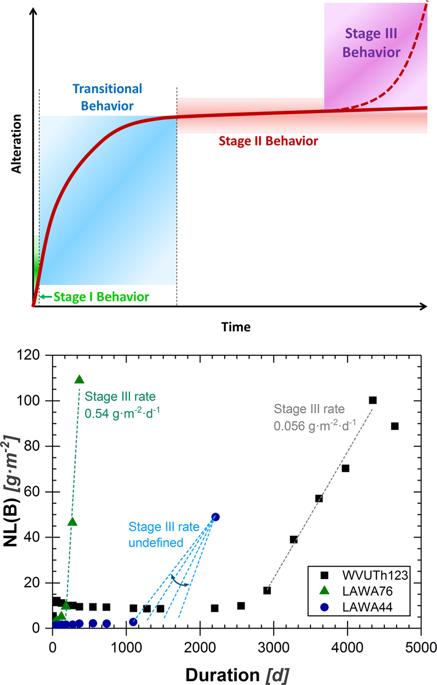npj Materials Degradation ( IF 6.6 ) Pub Date : 2019-10-16 , DOI: 10.1038/s41529-019-0095-0 Joseph V. Ryan , Benjamin Parruzot , Amanda M. Lines , Samuel A. Bryan , Lorraine M. Seymour , Jeffrey F. Bonnett , Radha K. Motkuri

|
Stage III glass dissolution, the occasionally observed tendency for accelerated aqueous corrosion after extensive time spent at low reaction rates, is a major area of technical uncertainty in long-term glass performance modeling for vitreous nuclear waste forms. Stage III dissolution behavior is thought to be caused by the precipitation of zeolite phases that lower the activity of the rate-controlling orthosilicic acid ion and cause the acceleration of glass dissolution. The uncertainty lies mainly in a poor understanding of the growth kinetics of these key crystalline phases. It is particularly important to understand the impact of temperature and pH conditions on Stage III behavior. Accurate analysis of this phenomenon is complicated by the typically very long (e.g., years), and variable length of the induction period preceding the onset of Stage III behavior. In this study of a high-sodium aluminoborosilicate glass, we demonstrate the ability to initiate the onset of Stage III behavior in a controllable fashion so as to both reduce the time delay of the incubation period, and to also be able to initiate Stage III dissolution in controlled conditions. In this case, we demonstrate that Stage III glass corrosion behavior is possible at 70 °C, a lower temperature than previously observed (90 °C), even in an unseeded experiment. We confirm, through a comparison study, that seeded and unseeded Stage III corrosion rates are equivalent. This enables wide-scale testing of Stage III corrosion rates for many glass compositions in relatively short times through this technique. We also report further development of the use of in situ Raman spectroscopy monitoring of boron concentration and pH through simple and chemometric analysis methods.
中文翻译:

使用拉曼光谱法现场监测种子和非种子III期腐蚀
第三阶段玻璃的溶解是在玻璃态核废料形式的长期玻璃性能模型中技术不确定性的一个主要领域,这是在低反应速率下花费大量时间后偶尔观察到的加速水腐蚀的趋势。认为第三阶段的溶解行为是由沸石相的沉淀引起的,这降低了控制速率的原硅酸离子的活性并导致玻璃溶解的加速。不确定性主要在于对这些关键结晶相的生长动力学缺乏了解。了解温度和pH条件对Stage III行为的影响尤为重要。通常通过非常长的时间(例如几年),对这种现象进行准确的分析变得很复杂,第三阶段行为开始之前的诱导期的可变长度。在这项高钠铝硼硅酸盐玻璃的研究中,我们证明了以可控的方式引发III期行为开始的能力,从而既可以减少孵育时间的延迟,又可以引发III期溶解在受控条件下。在这种情况下,我们证明即使在非播种实验中,在70°C(比以前观察到的温度(90°C)低的温度)下,III期玻璃的腐蚀行为也是可能的。通过比较研究,我们可以确认,播种和非播种的第三阶段腐蚀速率是相同的。通过这种技术,可以在较短的时间内对许多玻璃组合物进行III期腐蚀速率的大规模测试。











































 京公网安备 11010802027423号
京公网安备 11010802027423号